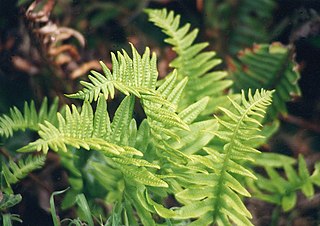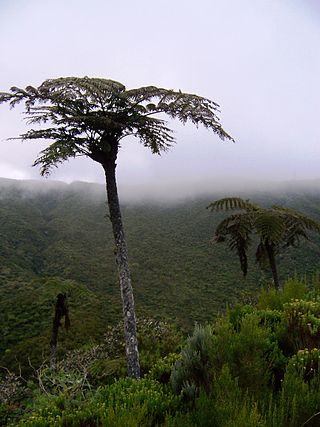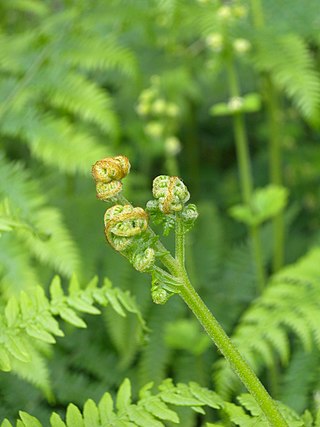
An epiphyte is an organism that grows on the surface of a plant and derives its moisture and nutrients from the air, rain, water or from debris accumulating around it. The plants on which epiphytes grow are called phorophytes. Epiphytes take part in nutrient cycles and add to both the diversity and biomass of the ecosystem in which they occur, like any other organism. They are an important source of food for many species. Typically, the older parts of a plant will have more epiphytes growing on them. Epiphytes differ from parasites in that they grow on other plants for physical support and do not necessarily affect the host negatively. An organism that grows on another organism that is not a plant may be called an epibiont. Epiphytes are usually found in the temperate zone or in the tropics. Epiphyte species make good houseplants due to their minimal water and soil requirements. Epiphytes provide a rich and diverse habitat for other organisms including animals, fungi, bacteria, and myxomycetes.

The tree ferns are arborescent (tree-like) ferns that grow with a trunk elevating the fronds above ground level, making them trees. Many extant tree ferns are members of the order Cyatheales, to which belong the families Cyatheaceae, Dicksoniaceae, Metaxyaceae, and Cibotiaceae. It is estimated that Cyatheales originated in the early Jurassic, and is the third group of ferns known to have given rise to tree-like forms. The others are the extinct Tempskya of uncertain position, and Osmundales where the extinct Guaireaceae and some members of Osmundaceae also grew into trees. In addition there were the Psaroniaceae and Tietea in the Marattiales, which is the sister group to most living ferns including Cyatheales.

A fern is a member of a group of vascular plants that reproduce via spores and have neither seeds nor flowers. The polypodiophytes include all living pteridophytes except the lycopods, and differ from mosses and other bryophytes by being vascular, i.e., having specialized tissues that conduct water and nutrients and in having life cycles in which the branched sporophyte is the dominant phase.

This article relates to the flora of New Zealand, especially indigenous strains. New Zealand's geographical isolation has meant the country has developed a unique variety of native flora. However, human migration has led to the importation of many other plants as well as widespread damage to the indigenous flora, especially after the advent of European colonisation, due to the combined efforts of farmers and specialised societies dedicated to importing European plants & animals.

The order Cyatheales, which includes most tree ferns, is a taxonomic order of the fern class, Polypodiopsida. No clear morphological features characterize all of the Cyatheales, but DNA sequence data indicate the order is monophyletic. Some species in the Cyatheales have tree-like growth forms from a vertical rhizome, others have shorter or horizontal expanding rhizomes.

Alsophila dealbata, synonym Cyathea dealbata, commonly known as the silver fern or silver tree-fern, or as ponga or punga, is a species of medium-sized tree fern, endemic to New Zealand. The fern is usually recognisable by the silver-white colour of the under-surface of mature fronds. It is a symbol commonly associated with the country both overseas and by New Zealanders themselves.

The order Polypodiales encompasses the major lineages of polypod ferns, which comprise more than 80% of today's fern species. They are found in many parts of the world including tropical, semitropical and temperate areas.

Where the Red Fern Grows is a 1961 children's novel by Wilson Rawls about a boy who buys and trains two Redbone Coonhounds for hunting. The book is a work of autobiographical fiction based on Rawls' own childhood in the Ozarks.

Dicksonia antarctica, the soft tree fern or man fern, is a species of evergreen tree fern native to eastern Australia, ranging from south-east Queensland, coastal New South Wales and Victoria to Tasmania.
Fern Tree is a rural / residential locality in the local government areas (LGA) of Hobart (64%) and Kingborough (36%) in the Hobart LGA region of Tasmania. The locality is about 9 kilometres (5.6 mi) south-west of the town of Hobart. The 2016 census recorded a population of 726 for the state suburb of Fern Tree.

The Cyatheaceae are a family of ferns, the scaly tree ferns, one of eight families in the order Cyatheales in the Pteridophyte Phylogeny Group classification of 2016. Alternatively, the family may defined much more broadly as the only family in the Cyatheales, with the PPG I family treated as the subfamily Cyatheoideae. The narrower circumscription is used in this article.

Dicksoniaceae is a group of tropical, subtropical and warm temperate ferns, treated as a family in the Pteridophyte Phylogeny Group classification of 2016, and counting 30-40 species. Alternatively, the family may be sunk into a very broadly defined family Cyatheaceae sensu lato as the subfamily Dicksonioideae. Most of the genera in the family are terrestrial ferns or have very short trunks compared to tree ferns of the family Cyatheaceae sensu stricto. However, some of the larger species can reach several metres in height. A number of others are epiphytes. They are found mostly in tropical regions in the Southern Hemisphere, as far south as southern New Zealand. Larger tree ferns in the genus Cibotium were formerly included in Dicksoniaceae, but are now segregated as the family Cibotiaceae.

FernGully: The Last Rainforest is a 1992 independent animated musical fantasy film. The feature directorial debut by Bill Kroyer, FernGully was scripted by Jim Cox and adapted from the "FernGully" stories by Diana Young. The film is an Australian and American venture produced by Kroyer Films, Inc., Youngheart Productions, FAI Films and 20th Century Fox. It stars the voices of Samantha Mathis, Tim Curry, Christian Slater, Jonathan Ward, Robin Williams, and Grace Zabriskie. FernGully is set in an Australian rainforest inhabited by fairies including Crysta, who accidentally shrinks a young logger named Zak to the size of a fairy. Together, they rally the fairies and the animals of the rainforest to protect their home from the loggers and Hexxus, a malevolent pollution entity. Wayne Young, the film's producer, said the film was "blatantly environmental" though made an effort to avoid "preaching".

Pteridaceae is a family of ferns in the order Polypodiales, including some 1150 known species in ca 45 genera, divided over five subfamilies. The family includes four groups of genera that are sometimes recognized as separate families: the adiantoid, cheilanthoid, pteridoid, and hemionitidoid ferns. Relationships among these groups remain unclear, and although some recent genetic analyses of the Pteridales suggest that neither the family Pteridaceae nor the major groups within it are all monophyletic, as yet these analyses are insufficiently comprehensive and robust to provide good support for a revision of the order at the family level.
Plants For A Future (PFAF) is an online not for profit resource for those interested in edible and useful plants, with a focus on temperate regions. Named after the phrase "plans for a future" as wordplay, the organization's emphasis is on perennial plants.

The Polypodiidae, commonly called leptosporangiate ferns, formerly Leptosporangiatae, are one of four subclasses of ferns, and the largest of these, being the largest group of living ferns, including some 11,000 species worldwide. The group has also been treated as the class Pteridopsida or Polypodiopsida, although other classifications assign them a different rank. Older names for the group include Filicidae and Filicales, although at least the "water ferns" were then treated separately.

The Masafuera rayadito is a rare bird endemic to Alejandro Selkirk Island in the Juan Fernández Islands. The species is a member of the ovenbird family and only one of three species in the rayadito genus. The species' natural habitat is humid montane scrub, dominated by tree ferns and ferns between 800–1300 m above sea level.

A stem is one of two main structural axes of a vascular plant, the other being the root. It supports leaves, flowers and fruits, transports water and dissolved substances between the roots and the shoots in the xylem and phloem, stores nutrients, and produces new living tissue. The stem can also be called halm or haulm or culms.

Southern Afrotemperate Forest is a kind of tall, shady, multilayered indigenous South African forest. This is the main forest-type in the south-western part of South Africa, naturally extending from the Cape Peninsula in the west, as far as Port Elizabeth in the east. In this range, it usually occurs in small forest pockets, surrounded by fynbos vegetation.

Roaring Billy Falls is a waterfall in Mount Aspiring National Park, Westland District, New Zealand. It is located in the Haast River valley, around 30 km (19 mi) inland from Haast, near Eighteen Mile Bluff on State Highway 6. The falls are a 30-metre-high (98 ft) cascade on The Roaring Billy stream. The bottom of the cascade is at an elevation of around 80 metres (262 ft) where it flows into the Haast River.


















